GSoC/2020/StatusReports/SaurabhKumar: Difference between revisions
m (→Week 2) |
m (→Week 2) |
||
| Line 55: | Line 55: | ||
[https://invent.kde.org/graphics/krita/-/merge_requests/392/diffs?commit_id=fccd367324d8266cba060c495b4de6a8d70daabf 16] | [https://invent.kde.org/graphics/krita/-/merge_requests/392/diffs?commit_id=fccd367324d8266cba060c495b4de6a8d70daabf 16] | ||
[https://invent.kde.org/graphics/krita/-/merge_requests/392/diffs?commit_id=52a0dd27e7befe5074fd12efc68045e9b7e7b703 17]) | [https://invent.kde.org/graphics/krita/-/merge_requests/392/diffs?commit_id=52a0dd27e7befe5074fd12efc68045e9b7e7b703 17]) | ||
[https://confifu.wordpress.com/2020/06/16/week-2-gsoc-project-report/ Blog post] | [https://confifu.wordpress.com/2020/06/16/week-2-gsoc-project-report/ Blog post] | ||
Revision as of 04:13, 26 August 2020
Storyboard Docker For Krita
Project Overview
A storyboard is a graphic organizer that consists of illustrations and comments displayed in sequence for the purpose of pre-visualizing and planning of motion picture and animation. The project was to implement a docker in Krita that would use the existing animation API in Krita to facilitate storyboarding. Qt's MVC classes are used for storing and displaying the storyboard.
Project Goals
The requirements of the project can be broken down into the following goals:
- Implementing the basic MVC classes for the docker.
- Integrating relevant parts of Krita, namely the timeline docker and canvas, with the storyboard docker.
- Implementing functionalities to export storyboard as PDF and SVG.
- User documentation.
The mockups prepared for the project:
Relevant Code and Technical Pre-requisites
MVC classes
Talk about MVC classes, comment and storyboard.
Krita's Anamtion API
Talk about Keyframe and keyframe channels. Talk about AnimationInterface Talk about the syncing and addition of keyframes.
Work Report
Implementing the MVC classes for the docker
Week -1
I started a few weeks early, to cover up for any unprecedented events due to ongoing COVID-19 crisis. This week I added the storyboard docker to Krita's plugin system and implemented the tool-buttons at the top of the docker and the menu related to those buttons. I implemented the CommentModel class to manage the comment tool-button's menu. The members of this menu would be part of the storyboard items that would be part of the storyboard model. I also started implemented the StoryboardModel class. (Commits :1)
Week 0
I implemented the delegate class for the CommentModel. I also added a visibility property to members of the CommentModel. This property is shown as an eye icon which can be toggled by clicking. I also implemented the StoryboardItem class that makes up the data of the StoryboardModel and implemented functions in StoryboardModel to manage that data. (Commits : 2, 6)
Also I implemented unit-tests for the CommentModel, StoryboardModel and the interactions between those classes.(Commits: 3, 4, 5)
Week 1
I implemented the view
(Commit: 9) and delegate (Commits:
8 10
11) classes for the StoryboardModel and debugged StoryboardModel(Commit:
7). The StoryboardView class inherits QListView because it has some useful functions, such as setFlow(...) and setWrap(...), that made implementing View and Modes very easy.
Week 2
I implemented the interactions between CommentModel and StoryboardModel
(Commits :
12
13
14). The interactions are set up so that any comments added to the CommentModel would add rows to each of the items in the StoryboardModel. Similarly with removing or renaming comments. I also implemented the visibility icon's functionality(Commit:
15). The StoryboardDelegate draws the comment only if its visibility is toggled on in the comment menu. Other than that I implemented the three modes row, column, grid. These modes change the layout of the items in the docker.(Commits:
16
17)
Week 3
(Commits : 18 19 20 21 22 23 24 25 26 27 28)
Week 4 and 5
(Commits : 29 30 31 32 33 34 35 36)
Integrating relevant parts of Krita with the storyboard docker
Week 6
I started implementing unit-tests for interactions between KisKeyframeChannel and StoryboardModel. The interactions are implemented using QSignals. First, signals are emitted from KisKeyframeChannel to KisImageAnimationInterface. Then KisImageAnimationInterface emits signals which are received by StoryboardModel. These tests are implemented in two parts, first to test signals from KisKeyframeChannel to KisImageAnimationInterface in KisKeyframeAnimationInterfaceSignalTest (Commit:
38) and second to test signals from KisKeyframeChannel to StoryboardModel in StoryboardTimelineSyncTest (Commit:
40)).
I moved some of the connections from StoryboardDockerDock to StoryboardModel to get the tests to work with only a StoryboardModel object (Commit:
39). Other than that I fixed some bugs.(Commit:
37)
Week 7
I added the remaining unit-tests for interactions between timeline and storyboard docker (Commit: 41) and changed filenames according to conventions used in Krita (Commit: 42). Other than that I changed update of thumbnails to occur only when the image is idle, which would improve performance when drawing on canvas (Commit: 43) and added some functions for handling rendering of all frames.(Commit: 44)
Week 8
I implemented the functionality for the duration field (Commit: 45) and addition of storyboard items from storyboard (Commit: 47).
I implemented the update of all affected items when a keyframe is changed. For this I implemented two classes KisStoryboardThumbnailRenderScheduler and KisAsyncStoryboardThumbnailRenderer. Whenever the KisImage is idle the current frame and all the affected frames are added to queues in KisStoryboardThumbnailRenderScheduler. This class then regenerates and emits KisPaintDevices for those frames one by one using KisAsyncStoryboardThumbnailRenderer which inherits KisAsyncAnimationRendererBase.(Commits:
48
49
50). I also posted on Krita Artists asking for feedback.
Other than that hellozee fixed building on Windows and I fixed some bugs. (Commits : 46 51 52 53)
Implementing functionalities to export storyboard
Week 9 and 10
I implemented the saving and loading of storyboards. For this I stored a QVector of Comment and a StoryboardItemList in KisDocument. This version of data is kept in sync with the version that is inside CommentModel and StoryboardModel.(Commits:
57
58
59
62)
I also added unit-tests for saving and loading of storyboards. These tests were added in kis_kra_saver_test.cpp. (Commit: 56)
I worked on the Export dialog GUI and implemented some of its functions.(Commits:
63
64)
Other than that I added a patch from Eoin O'Neil, fixed some bugs and merged my branch with master. (Commits : 54 55 60 61 65 66)
Week 11 and 12
(Commits : 67 68 69 70 71 72 73 74 75 76 77 78 79 80)
Introduction
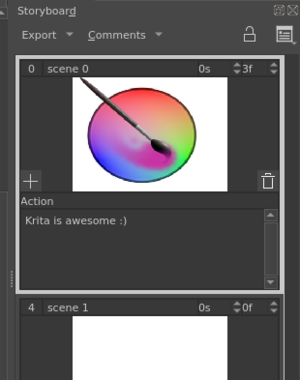
The storyboard docker aims to facilitate storyboarding in Krita. It allows multiple images and associated text to be organized in the form of a storyboard. The arrangement can be tweaked using the mode and view options. Also different field's visibility can be toggled. The storyboard can be rendered as pdf or svg.

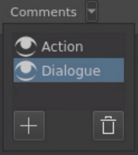
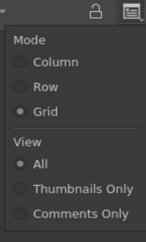
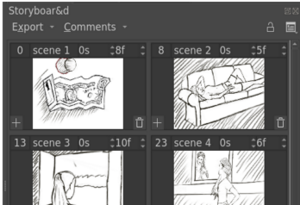
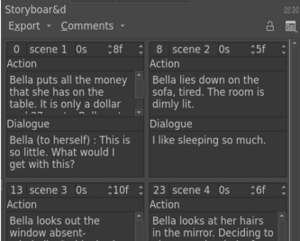
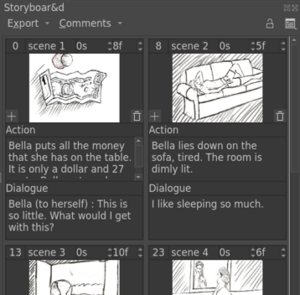
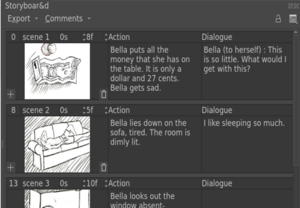


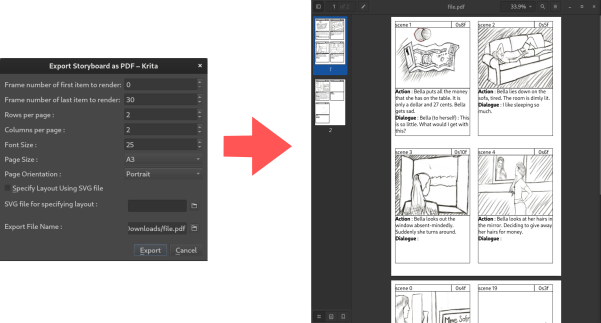


Deliverables
- Link to Phabricator task: T12819
- Krita Artists thread: Storyboard feature plans and mockups
- Merge Request : !392
- Blogs : here
